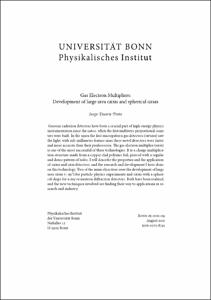Duarte Pinto, Serge: Gas Electron Multipliers : Development of large area GEMS and spherical GEMS. - Bonn, 2012. - Dissertation, Rheinische Friedrich-Wilhelms-Universität Bonn.
Online-Ausgabe in bonndoc: https://nbn-resolving.org/urn:nbn:de:hbz:5N-27422
Online-Ausgabe in bonndoc: https://nbn-resolving.org/urn:nbn:de:hbz:5N-27422
@phdthesis{handle:20.500.11811/5090,
urn: https://nbn-resolving.org/urn:nbn:de:hbz:5N-27422,
author = {{Serge Duarte Pinto}},
title = {Gas Electron Multipliers : Development of large area GEMS and spherical GEMS},
school = {Rheinische Friedrich-Wilhelms-Universität Bonn},
year = 2012,
month = jan,
note = {Gaseous radiation detectors have been a crucial part of high-energy physics instrumentation since the 1960s, when the first multiwire proportional counters were built. In the 1990s the first micropattern gas detectors (MPGDs) saw the light; with sub-millimeter feature sizes these novel detectors were faster and more accurate than their predecessors. The gas electron multiplier (GEM) is one of the most successful of these technologies. It is a charge multiplication structure made from a copper clad polymer foil, pierced with a regular and dense pattern of holes. I will describe the properties and the application of GEMs and GEM detectors, and the research and development I have done on this technology. Two of the main objectives were the development of large area GEMs (~m^2) for particle physics experiments and GEMs with a spherical shape for x-ray or neutron diffraction detectors. Both have been realized, and the new techniques involved are finding their way to applications in research and industry.},
url = {https://hdl.handle.net/20.500.11811/5090}
}
urn: https://nbn-resolving.org/urn:nbn:de:hbz:5N-27422,
author = {{Serge Duarte Pinto}},
title = {Gas Electron Multipliers : Development of large area GEMS and spherical GEMS},
school = {Rheinische Friedrich-Wilhelms-Universität Bonn},
year = 2012,
month = jan,
note = {Gaseous radiation detectors have been a crucial part of high-energy physics instrumentation since the 1960s, when the first multiwire proportional counters were built. In the 1990s the first micropattern gas detectors (MPGDs) saw the light; with sub-millimeter feature sizes these novel detectors were faster and more accurate than their predecessors. The gas electron multiplier (GEM) is one of the most successful of these technologies. It is a charge multiplication structure made from a copper clad polymer foil, pierced with a regular and dense pattern of holes. I will describe the properties and the application of GEMs and GEM detectors, and the research and development I have done on this technology. Two of the main objectives were the development of large area GEMs (~m^2) for particle physics experiments and GEMs with a spherical shape for x-ray or neutron diffraction detectors. Both have been realized, and the new techniques involved are finding their way to applications in research and industry.},
url = {https://hdl.handle.net/20.500.11811/5090}
}






